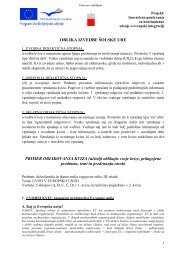national system of innovation in slovenia - Mednarodni odnosi
national system of innovation in slovenia - Mednarodni odnosi
national system of innovation in slovenia - Mednarodni odnosi
Create successful ePaper yourself
Turn your PDF publications into a flip-book with our unique Google optimized e-Paper software.
15<br />
2. MACROECONOMIC PERFORMANCE AND FRAMEWORK<br />
CONDITIONS FOR INNOVATION<br />
2.1 Drivers <strong>of</strong> macro-economic growth<br />
With stable and dynamic economic growth from 1997 to 2007 Slovenia constantly<br />
decreased development gap compared to the EU. Inter<strong>national</strong> trade (foreign demand<br />
<strong>in</strong> particular) has been the major driver <strong>of</strong> economic growth and <strong>in</strong>ter<strong>national</strong><br />
<strong>in</strong>tegration, while foreign direct <strong>in</strong>vestment that could potentially <strong>in</strong>crease<br />
productivity and technological upgrad<strong>in</strong>g rema<strong>in</strong>ed modest and less important<br />
than <strong>in</strong> other new EU member states (Table 2.2.1). 1 Economic crises has reduced<br />
trade flows significantly and economic activity decl<strong>in</strong>ed sharply <strong>in</strong> late 2008 and<br />
2009 2 (Figure 2.1.1), which <strong>in</strong>terrupted the implementation <strong>of</strong> the Slovenia’s Development<br />
Strategy goals <strong>in</strong> the field <strong>of</strong> economic and social development (IMAD<br />
2010). As for the non-achievement <strong>of</strong> the goals <strong>in</strong> R&D and <strong><strong>in</strong>novation</strong> area, the<br />
reasons go beyond the economic crisis alone.<br />
The crisis almost wiped out progress <strong>in</strong> the field <strong>of</strong> economic and social development<br />
result<strong>in</strong>g from strong GDP growth and ris<strong>in</strong>g employment <strong>in</strong> the period<br />
<strong>of</strong> favourable economic trends. Slovenia failed to take advantage <strong>of</strong> those times for<br />
radical changes to facilitate technological breakthroughs and susta<strong>in</strong>able development.<br />
The crisis has exposed numerous structural weaknesses, particularly the<br />
fact that Slovenia’s GDP growth is overly dependent on low-technology <strong>in</strong>dustries<br />
and traditional services, which limit the competitive edge <strong>of</strong> its economy. A quick<br />
return to the trajectory <strong>of</strong> economic recovery and improvement <strong>of</strong> the population’s<br />
welfare is therefore a great challenge for Slovenia, especially as the economic<br />
crisis severely affected the medium-term fiscal position and availability <strong>of</strong> sources<br />
<strong>of</strong> f<strong>in</strong>ance, and as the level <strong>of</strong> potential GDP also dropped. Relatively low growth<br />
<strong>of</strong> economic activity and employment <strong>in</strong> the com<strong>in</strong>g years will be reflected <strong>in</strong><br />
modest growth <strong>in</strong> general government revenue, which will make the consolidation<br />
<strong>of</strong> public f<strong>in</strong>ances even harder.<br />
1 With 29 % share <strong>of</strong> <strong>in</strong>ward FDI stock <strong>in</strong> GDP Slovenia lags beh<strong>in</strong>d EU average (35 %) and also<br />
other new EU member states (UNCTAD 2009).<br />
2 Global trade decl<strong>in</strong>ed <strong>in</strong> 2009, and Slovenia’s exports were down 15 %. The largest decl<strong>in</strong>e <strong>in</strong><br />
domestic demand was recorded by <strong>in</strong>vestment, at 30 %. Private consumption also decl<strong>in</strong>ed,<br />
but government spend<strong>in</strong>g <strong>in</strong>creased.





